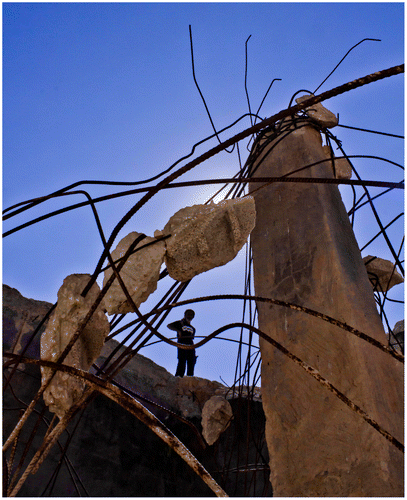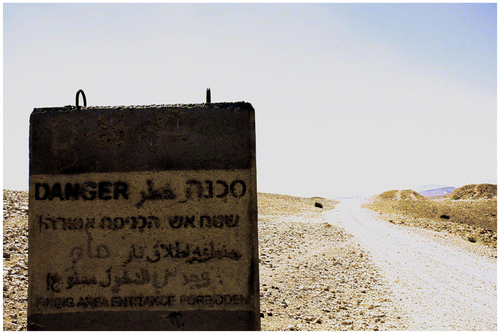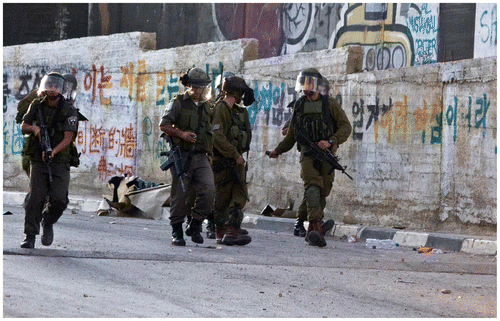The conflict and socioeconomic isolation that has been engendered by the policies of settlement expansion and separation barrier construction is arguably the most pervasive threat to the health of Palestinians in the West Bank. The acquisition of 60% of the West Bank, known as Area C, for ‘near exclusive’ Israeli control has become a major obstacle to delivering essential services according to the United Nations Office for the Coordination of Humanitarian Affairs (UNOCHA Citation2013). The example of Western Bethlehem is typical of the broader situation across the West Bank where the completion of the separation barrier is projected to reduce access to essential services for over 23,000 Palestinians by separating nine communities from their surrounding agricultural lands (UNOCHA Citation2013b).
Aida Refugee camp, with some 5,000 refugees registered with United Nations Relief and Works Agency for Palestine Refugees (UNRWA Citation2013), is situated within the town of Bethlehem. Presently, the Israeli Defence Force (IDF) is stationed at watchtowers along the separation barrier between Aida and the Israeli settlements of Har Homa and Har Gilo. Clashes between refugees in the camp and the IDF have now become a matter of routine. Typically, the IDF respond to stone-throwing protesters using tear gas canisters and rubber-coated metal bullets (a type of ‘non-lethal’ round used with conventional weapons) (Figure ).
Figure 1. An IDF patrol firing a tear gas towards protesters, Aida refugee camp, Bethlehem (Photo: Guglielmo Chelazzi Grandinetti).

Serious injury is a common outcome on both sides, but the predominance of injuries to children is particularly concerning. Whilst some children are actively engaged in stone-throwing, most are simply bystanders. In one such incident witnessed by PB, GCG and anon, following the arrival of the Palestinian Civil Police Force to disperse a small stone-throwing crowd, two rubber bullets were fired by the IDF patrol. The first hit a teenager in the leg, whilst the second passed further behind the police line, unfortunately hitting a seven-year-old boy in the head causing major peri-orbital trauma. Although IDF engagement rules require rubber bullets to be aimed at the legs; the reality is that these rounds strike all parts of the body. Misaimed rubber bullets are not the only threat to children, with the use of stun grenades (Figure ) and a worrying increase in the number of tear gas and canister injuries documented (UNOCHA Annual Report Citation2013).
Contact rules currently operated by the IDF also mean that there is no discrimination over location of engagement with protesters. The Lajee community centre in Aida camp mostly looks after children between the ages of three to fifteen, but it is currently the focus of hostile clashes between the IDF and protesters. As IDF patrols are an almost daily event, it is not unusual for occupants of the community centre to be exposed to more than two hours of tear gas, two to three times per month. The evacuation of the centre is difficult when rubber bullets pose a serious threat of injury to the children when outside. The work of James Garbarino has examined how exposure to chronic violence poses a serious threat to childhood development (Garbarino Citation2001). Presently, this long-term exposure is undermining the efforts of community workers.
Additionally, the isolation enforced by the separation barrier and frequent military operations also creates a real stranglehold preventing Palestinians from accessing essential services such as education, health or even water. Our fieldwork outside the camp documented the military demolition of wells in the Bedouin village of Umm Al Kheer, south of Bethlehem and Hebron (Figure ). The Bedouin of the West Bank rely on access to water for subsistence farming and herding. (UNOCHA 2012 Annual report, Citation2013, p.65). It is evident that the Bedouin are an extremely vulnerable population in both Israel and Palestine and will likely face similarly poor health outcomes as those we have observed in Aida and Dheisheh Refugee Camps.
Figure 3. A Palestinian Bedouin standing on the edge of a destroyed well built by the villagers of Umm Al Kheer.

The interactions between settlers, soldiers and Palestinians are enforcing a worrying trend towards a self-perpetuating cycle of violence. The ability to record such injuries caused by violence is highly relevant for both policy and diplomacy, in order to allocate limited resources more effectively. UNOCHA undertook surveillance in the West bank indicating showing that in 2012, 3179 injuries and 9 fatalities were due to direct conflict, the majority of these were from riot dispersal methodsFootnote1. In 2013, with increasing ‘search and arrest operations’ by the IDF, UNOCHA reports a concerning increase in the rate of injuries, particularly to children1. Further to this, there is no evidence of any military accountability for injuries inflicted.
We found a notable absence of injury surveillance within UNRWA health centres. Health workers report an inability to record such data due to potential loss of identifiable patient information to the IDF resulting in a risk to the patient which may include imprisonment for involvement in protests. Additionally, capacity to collect injury data is limited both by time-constraints and paper-based record keeping. The local health centre in Dheisheh Refugee Camp, near Bethlehem provides free primary care for more than 17,000 registered refugees, including those from AidaFootnote2, equating to 107 daily patient consultations per doctor.
More broadly, the continued development of the separation barrier and settlement expansion are creating an environment where IDF operations bring the local population into continued exposure to riot dispersal methods and their associated morbidity and injury. Most Palestinians have seen access to their most basic needs cut down by the barrier itself, settlement expansion or even by marking the areas around them as Area C and subsequently declaring these as military ‘Firing Zones’ (see footnote 1) (Figure ).
Figure 4. A sign marking the beginning of an area turned into a ‘Firing Zone’ almost completely surrounding a Bedouin village south-east of Hebron. This is Firing Zone 918. (UNOCHA, Citation2013, p.23–24)

Inevitably, these policies of separation barrier construction and settlement expansion will lead to poorer health outcomes across the population. A resolution to this is imminently required for both sides to the conflict, particularly given that the next generation consists of a young urban demographic. Solving this will require a political solution to halt further settlement expansion and cessation of construction of the separation barrier in Western Bethlehem, alongside a much broader rethinking of the ‘strategic impasse’ of IDF operations within the West Bank due to the implications for Israel’s long-term security and Palestinian health (Catignani Citation2005).
Notes on contributors
Patrick Bogue is a fifth year medical student from Belfast, Northern Ireland. He completed a BSc in Global health at King’s College, London. In August 2013, he completed a combined clinical and refugee camp (RECAP) placement with IPPNW in Dheisheh and Bethlehem UNRWA health centres for four weeks working alongside UNRWA health professionals. As part of a group of European and Palestinian medical students he assisted in community work with children in Aida refugee camp.
Richard Sullivan is director of the Kings Health Partners Institute of Cancer Policy and Global Health. He has worked extensively in post-conflict environments across Europe, the Middle East, Africa and Asia, with research interests ranging from health system reconstruction to cancer care in low- and middle income countries. He is an academic lecturer at King's College London, teaching on the conflict and security module for the Global Health iBSc. He is also involved in the Lancet Commission for Global Surgery 2013–2014.
Our third author is a final-year medical student from Al-Quds University in the occupied Palestinian territory. For specific reasons they have requested anonymity for this commentary.
Guglielmo Chelazzi Grandinetti is completing a BSc in the Science of Education at the University of Florence. He is a former Italian army soldier who was stationed with NATO in Herat, Afghanistan. He is also an experienced photographer and undertook fieldwork both in Aida Refugee Camp and with the Bedouin community of Umm Al Kheer near Hebron. He provided expert insight on IDF patrol activities and strategy and is responsible for all photography in this piece. He is currently studying the Science of Education at the University of Florence in Italy.
Acknowledgements
We wish to thank both International Physicians for the Prevention of Nuclear War (IPPNW) for their continued support for this fieldwork. Refugee Camp Project (RECAP): founded in 2003, IPPNW students developed RECAP to help refugees in Chiapas, Zambia, the Netherlands, Germany, Philippines and the former Yugoslavia. (http://www.ippnw.org/medical-students.html) [accessed 8 November 2013].) We are extremely grateful to IFMSA (International Federation of Medical Students’ Associations) – Palestine. Our warm gratitude is also extended towards all those who support this program Al-Quds University, UNRWA Bethlehem and Dheisheh health centres, UNOCHA Jerusalem, the Palestinian Centre for Human Rights and Badil in Ramallah, oPt. And hanks to Ray Dolphin, Barrier Specialist at UNOCHA, oPt for the expert overview of humanitarian crises in the oPt. Lastly, thanks to all of the staff and children at Lajee community centre, for your hospitality and courage in extremely difficult circumstances.
Notes
1. See UNOCHA (2013).
2. See UNRWA (2013)..
References
- Catignani, S. 2005. “The Strategic Impasse in Low-Intensity Conflicts: The Gap Between Israeli Counter-Insurgency Strategy and Tactics During theAl-Aqsa Intifada.” Journal of Strategic Studies 28 (1): 57–75.
- Garbarino, J. 2001. “An Ecological Perspective on the Effects of Violence on Children.” Journal of Community Psychology 29 (3): 361–378.
- UNOCHA. May 2013. oPt. Annual Report 2012. Fragmented Lives. Humanitarian Overview 2012: 7–8.
- UNOCHA (United Nations Office for the Coordination of Humanitarian Affairs). 2013a. Area C of the West Bank: Key Humanitarian Concerns. January 2013. Accessed September 23, 2013. http://www.ochaopt.org/documents/ocha_opt_barrier_factsheet_july_2012_english.pdf
- UNOCHA (United Nations Office for the Coordination of Humanitarian Affairs). 2013b. The Humanitarian Impact of the Barrier. July 2013. Accessed September 23, 2013. http://www.ochaopt.org/documents/ocha_opt_area_c_factsheet_January_2013_english.pdf.
- UNRWA (UN Relief and Works Agency for Palestine Refugees). 2013. Where We Work. Accessed September 22, 2013. http://www.unrwa.org/where-we-work/west-bank/camp-profiles?field=12.

